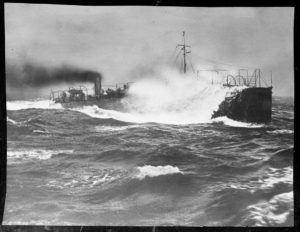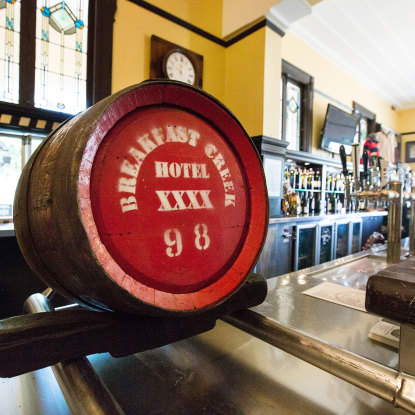Like most people who brew for fun, or a living, I think my journey was unique. I was a late bloomer in the home-brewing sense and then went crazy about four batches in. All-grain, stainless, temp-controlled everything, kegerators, brew clubs, competitions, blah, blah blah. I basically became completely obsessed and turned my garage, dining room and basement into everything beer related. I have enjoyed some success in competitions, and numerous friends who drink my free beer have told me my beer is great (not the best litmus test based on the word free, mind you).
 At this point in the homebrew infatuation, who hasn’t thought of quitting their day job and going pro? After five or more beers, just about every serious beer drinker (let alone brewer) with whom I’ve ever had a conversation mutters something along the lines of: “Wouldn’t it be effing cool to own your own brewery?” Well, I’ve asked myself, and my adorable wife, that question many, many times.
At this point in the homebrew infatuation, who hasn’t thought of quitting their day job and going pro? After five or more beers, just about every serious beer drinker (let alone brewer) with whom I’ve ever had a conversation mutters something along the lines of: “Wouldn’t it be effing cool to own your own brewery?” Well, I’ve asked myself, and my adorable wife, that question many, many times.
So just how do you go from brewing beer in your kitchen or garage to working in a real brewery? I found that two factors affect the outcome here.
- You need to have the extra time available to put in a few shifts a week at a brewery.
- The Latin adage: Audentes Fortuna Iuvat – “Fortune helps those daring.”
Save the younger among us, there are very few chances to take on a second job for fun. Most of us have family or job commitments that make this impractical or impossible. And those who do need a second job, usually take one that suits their needs, not their dreams. As a guy with life-long “shit for luck,” I lucked out for once. I was afforded the opportunity to take a one-year assignment in Hawaii. I know, tough life for sure, right? There were a few catches to this assignment. I was going to be working on all new projects that I knew nothing about, could not take a workday off for 51 weeks, and had to leave my aforementioned adorable wife behind. This meant that I would be living the bachelor life for a year, surviving on ramen and beer, but with plenty of spare time for a second job….so extra time available to put in a few shifts a week at a brewery? – check.
Now for finding that brewery.
A week-long business trip to Hawaii about three months before my new job started meant I could scout out the potential breweries in advance. This is how I approached it:
- At the time I was looking, there were five breweries open or in planning. One was still on paper, so that left four to pursue. (By the way, four months later, there are seven breweries in Hawaii)
- I contacted the four breweries via email, Facebook, and Twitter to start a discussion, gave my background and discussed my passion for both learning and beer, and offered to work for FREE (which we will discuss later). I thought the internship approach (since I already had a paycheck coming in) would take the pressure off the “hiring process.”
- Two breweries responded and I started putting together some possible dates to interview.
- By the time I flew to Hawaii, one brewery owner had not confirmed our appointment, so I was now down to one.
- I met with the Brewmaster and didn’t give him any BS about what a great a brewer I was. I dropped off three of my own beers and three more he would never see in Hawaii (Double IPAs of course). I think we hit it off immediately.
- During my five-minute “interview,” I reiterated that I wanted to learn ALL the aspects of working in a brewpub — from cleaning kegs and tap lines, to dumping spent grains, to cleaning the kettles, etc.
- My new boss agreed to take me on as a “volunteer” on the spot. I was to be the brewery’s first volunteer brewer, and so my journey started to reveal itself.
I am starting with one weekend shift each week, which should be about 10-12 hours in duration. I will start at the very bottom, doing the mundane and the dirty, just like everyone else. Although I will be “earning my stripes,” I have still set goals. The first is to put together one beer that I can say I brewed, conditioned, kegged, and served all by myself in 50 weeks. My loftier goal is to brew a collaboration recipe with the pro brewers to be entered into the Great American Beer Festival in the “PRO-AM” category. I have one year to make it all happen.
I will be documenting the journey along the way. It won’t always be pretty, or very fun, but I intend to share how it goes. So lift your glass and wish me luck.



 I had another interesting experience with cask conditioned beer on my second trip to Brisbane, Australia. A friend of mine had been there many times, and knew of a place called The Breakfast Creek Hotel (the locals call it the “Brekky Creek”). This place had the best steak house going (the kind where you choose your steak in the case) and the Paddy Fitzgerald Bar, a really cool bar that still serves cask ale. The beer was XXXX Bitter (spoken “four-ex”),made by Castlemain Perkins in Brisbane, Australia. On its own merit, XXXX Bitter is a good beer, a kind of English bitter hybridized with a Czechoslovakian lager yeast. It is great, 4.6% ABV, and crushable. The XXXX Bitter on cask at the Brekky Creek is from another world. There is something amazing that happens in the cask. I don’t know if it is the brewers pitch, the wood, the tradition, or the specter of seeing it tapped with a hammer…but it is amazingly different. I have consumed many, many pints of XXXX Bitter, “off the wood” as the barman says, while at the Brekky Creek and they were all amazing. The cask mellows all the flavors a bit. The bittering from the hops is toned down, and the wood adds a different mouthfeel than you would get from a bottle of standard CO2 draught. The differences to most people would be significant enough to suggest the cask and non-cask versions of the same beer were actually two different beers. As a really cool side note to the Paddy Fitzgerald Bar fame, I would add that they have a very interesting tradition regarding a tapped cask. They finish it that day. Don’t get me wrong, they are small casks (10 gallons/38 liters I believe), but those of you sitting in the bar within an hour of closing could get a special treat. The last time I was there, in 2006, I happened to be there with only four other patrons – two locals and three of us Sailors. The locals kindly accepted the free pitcher that the barman poured for them and took a while to consume it. My friends and I went through pitcher after pitcher of wonderful beer while discussing such lofty topics as US football vs. Rugby, Rugby Union, and Australian Rules. We also debated who had consumed more, and which of us had the largest bladder (Big Head Todd drank way more, and I had the largest bladder).
I had another interesting experience with cask conditioned beer on my second trip to Brisbane, Australia. A friend of mine had been there many times, and knew of a place called The Breakfast Creek Hotel (the locals call it the “Brekky Creek”). This place had the best steak house going (the kind where you choose your steak in the case) and the Paddy Fitzgerald Bar, a really cool bar that still serves cask ale. The beer was XXXX Bitter (spoken “four-ex”),made by Castlemain Perkins in Brisbane, Australia. On its own merit, XXXX Bitter is a good beer, a kind of English bitter hybridized with a Czechoslovakian lager yeast. It is great, 4.6% ABV, and crushable. The XXXX Bitter on cask at the Brekky Creek is from another world. There is something amazing that happens in the cask. I don’t know if it is the brewers pitch, the wood, the tradition, or the specter of seeing it tapped with a hammer…but it is amazingly different. I have consumed many, many pints of XXXX Bitter, “off the wood” as the barman says, while at the Brekky Creek and they were all amazing. The cask mellows all the flavors a bit. The bittering from the hops is toned down, and the wood adds a different mouthfeel than you would get from a bottle of standard CO2 draught. The differences to most people would be significant enough to suggest the cask and non-cask versions of the same beer were actually two different beers. As a really cool side note to the Paddy Fitzgerald Bar fame, I would add that they have a very interesting tradition regarding a tapped cask. They finish it that day. Don’t get me wrong, they are small casks (10 gallons/38 liters I believe), but those of you sitting in the bar within an hour of closing could get a special treat. The last time I was there, in 2006, I happened to be there with only four other patrons – two locals and three of us Sailors. The locals kindly accepted the free pitcher that the barman poured for them and took a while to consume it. My friends and I went through pitcher after pitcher of wonderful beer while discussing such lofty topics as US football vs. Rugby, Rugby Union, and Australian Rules. We also debated who had consumed more, and which of us had the largest bladder (Big Head Todd drank way more, and I had the largest bladder).